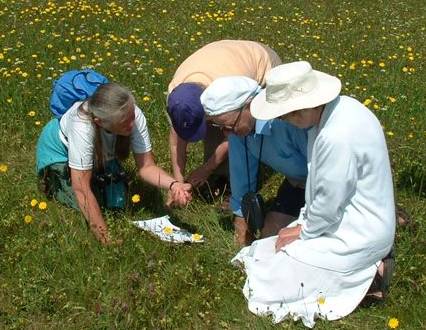 So it was that we soon found ourselves sitting on the edge of a pretty flower meadow getting very close to our subject matter, and being advised on some of the basics of flower watching, not too similar to bird watching. i.e.
So it was that we soon found ourselves sitting on the edge of a pretty flower meadow getting very close to our subject matter, and being advised on some of the basics of flower watching, not too similar to bird watching. i.e.| Back to the Index page |
On a beautiful summer day twelve members and guests attended the workshop held by Gill Smith and Nan Sykes. Why Ravenscar? Well, this piece of clifftop doesn’t have any especially rare plants (although frog orchids have been found in the past) but it does have a large range of habitats and plant life, ideal for a botany workshop.
Gill was our main teacher and explained that her objectives for the day were to:
 So it was that we soon found ourselves sitting on the edge of a pretty flower meadow getting very close to our subject matter, and being advised on some of the basics of flower watching, not too similar to bird watching. i.e.
So it was that we soon found ourselves sitting on the edge of a pretty flower meadow getting very close to our subject matter, and being advised on some of the basics of flower watching, not too similar to bird watching. i.e.
• What does it look like?
•
Would you expect to see this plant in this location?
The ‘what does it look like?’, apart from obvious things like size and colour, does become much more complicated when trying to decide exactly what the plant is, and Gill dealt with this later.
So – you come across an unknown plant. Before opening your identification book, most of which are coded by flower colour and number of petals, have a look to see what the habitat is – the basic habitats being grassland, arable, woodland, moor and bog. Then when using the book see what the plant is most likely to be in the habitat you are in, and indeed check the distribution maps to see whether it is found in your area at all.
Gill broke us in gently by talking about plant families and names, using the dandelion like Cat’s Ear as an example of an aptly named common plant. Then we moved on to buttercups – where we all felt competent in identifying the numerous yellow flowers in the field as buttercups, but then we were told there were three common varieties, and four more less common – and they all look like buttercups!!!
So, out with the hand lenses (an essential aid, preferably ×10) and instead of having to study the book Gill showed us what to look for:
Meadow buttercup – tall, smooth hairy stalk, upright sepals.
Creeping buttercup – creeps, furrowed hairy stalk, upright sepals
Bulbous buttercup – upright, furrowed stalk, turned-down sepals.
Luckily these three commonest buttercups were all on site, so at first it all seemed to be pretty straightforward!
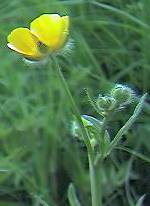 |
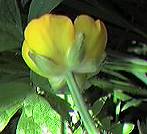 |
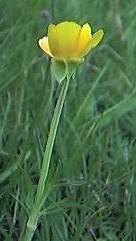 |
| Meadow buttercup | Creeping buttercup | Bulbous buttercup |
We were then shown another yellow-flowered plant in the meadow which some members correctly identified as yellow rattle (also known as hay rattle). This plant is interesting as it is a semi-parasitic annual living in poor pasture, and it has become much rarer due to the modern farm practices of increased use of fertiliser and early cutting for silage/hay. Again the name gives us a clue to the plant as late in the season the seed pods do indeed rattle.
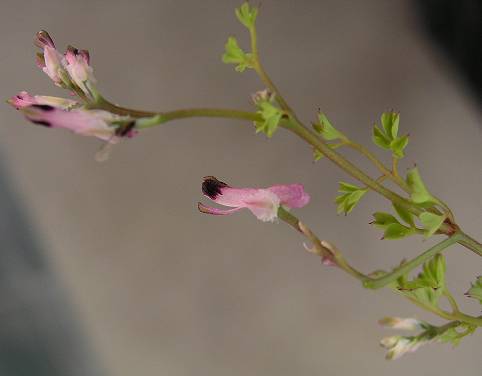 After showing us some more meadow plants, we then moved on to the hedgerow and arable areas where we saw many other examples of what we felt were common plants, but all sometimes was not as it seemed – and more unusual varieties were pointed out. For example Nan was very happy to find a fumitory (with the wonderful name of Common Ramping Fumitory, Fumaria muralis – photo right) which is very similar to the arable weed, common fumitory, but much less common.
After showing us some more meadow plants, we then moved on to the hedgerow and arable areas where we saw many other examples of what we felt were common plants, but all sometimes was not as it seemed – and more unusual varieties were pointed out. For example Nan was very happy to find a fumitory (with the wonderful name of Common Ramping Fumitory, Fumaria muralis – photo right) which is very similar to the arable weed, common fumitory, but much less common.
We then had an enjoyable lunch break overlooking north Ravenscar and Robin Hood’s Bay, digesting what we had learned from Gill and Nan. As a very inexperienced botanist I had learned to try and be more logical and thorough in examining and appreciating the world beneath our feet, and was happy to have achieved the objective of being able to identify one new plant (the fumitory) – but there is a long way to go.
Birdlife on the clifftop was very quiet as one would expect at this time of year, and looking downwards we didn’t see much! However we were serenaded frequently by whitethroats and willow warblers (not unfortunately by corn buntings which Nan advised were common thirty years ago).
One member found a small adder skin which presumably had been sloughed off as the young snake grew bigger.
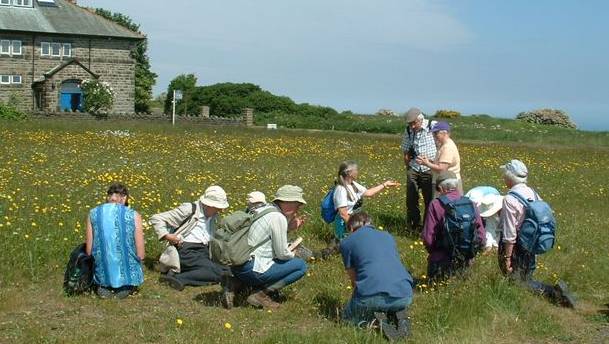
Group photo at Ravenscar station
| Tom Denney | Back to the Top |
| © Ryedale Natural History Society 2006 Photos © Tom Denney 2006, © Nan Sykes 2006 (fumitory) and © Gill Smith 2003 (buttercups) |
Back to the Index page |